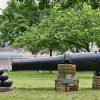calsfoundation@cals.org
CSS Pontchartrain
The CSS Pontchartrain was a Confederate warship that served on the Arkansas and White rivers. While it never saw combat in Arkansas, the Pontchartrain played a supporting role in several battles and affected Union strategy in 1862 and 1863.
The CSS Pontchartrain began its career as the Lizzie Simmons, a 454-ton sidewheel paddleboat built at New Albany, Indiana, in 1859. The Lizzie Simmons ran between New Orleans, Louisiana, and the Ouachita River in 1860 under Captain George Hamilton Kirk; it then worked the river between New Orleans and Memphis, Tennessee, under Captain W. B. Richardson. The Confederate navy purchased the ship in October 12, 1861, and converted it into a gunboat in January and February 1862. It was renamed the CSS Pontchartrain and sent to Columbus, Kentucky, under the command of Capt. John W. Dunnington, a former officer in the U.S. Navy.
The Pontchartrain served at New Madrid, Missouri, and Island No. 10 on the Mississippi River before being dispatched, along with sister ship CSS Maurepas, to prowl the Arkansas and White rivers. The crews of the two warships saw their first Arkansas action at St. Charles (Arkansas County) on the White River. On June 8, 1862, the Pontchartrain brought two 32-pounder rifled cannon to defend the river there, with Dunnington placing them in earthworks on a bluff at a bend in the river. The gunboat returned to Little Rock (Pulaski County) for repairs; then Dunnington returned to St. Charles with some of his sailors to work the guns. On June 17, when a Union flotilla sailed up the White to bring supplies to General Samuel R. Curtis’s Army of the Southwest, the Maurepas and two steamers were scuttled to block the river channel. Despite a shot that burst the steam drum of the USS Mound City, killing or wounding approximately 150 sailors, the defenders of St. Charles were easily overwhelmed, though Dunnington and his men escaped.
On September 28, 1862, Dunnington was placed in charge of fortifying the Arkansas River. A major earthwork was established at Arkansas Post (Arkansas County), and the Pontchartrain steamed there to offload its heavy guns for placement in Fort Hindman. Dunnington and thirty-five of his sailors remained there to man them, with the Pontchartrain returning to Little Rock to be converted into a ram. A Union army under General John McClernand, accompanied by a flotilla of Federal gunboats, attacked Arkansas Post on January 10 and 11, 1863, and Dunnington and his surviving men became prisoners of war when the post surrendered.
The Pontchartrain remained a matter of concern to the Union navy in Arkansas, with Rear Admiral David D. Porter warning on January 17 that “there is a ram, Pontchartrain, up the Arkansas. She draws 10 feet and can only come down on a high rise. Look out for her.” On February 6, 1863, Lieutenant-Commander Thomas O. Selfridge of the USS Conestoga proposed a daring run up the Arkansas River, braving two bluff-top batteries on the way, to destroy the ram, which was being armored with wood and railroad iron. The attack never happened, and Selfridge reported on April 11 rumors that the Pontchartrain was preparing to head down river to attack his vessel, a sortie that also failed to occur.
As General Frederick Steele’s Union army marched across eastern Arkansas to capture Little Rock in the summer of 1863, the Pontchartrain began showing up in Federal reports again. Lieutenant George M. Bache reported on July 17 that “the gunboat Pontchartrain is at Little Rock, only waiting for the fall of the water to be sheathed as a ram.” Admiral Porter reported on August 24 that “Lieutenant Dunnington…is fitting out at Little Rock the Pontchartrain, the last ram the rebels have in these waters. I shall be glad to see her this side of the shoals that have prevented us from reaching her before.” The Pontchartrain never sallied forth against Union shipping. When Steele’s army took Little Rock on September 10, 1863, it was burned and destroyed to keep it from falling into Federal hands.
For additional information:
Bearss, Edwin C. “The Battle of the Post of Arkansas.” Arkansas Historical Quarterly 18 (Autumn 1959): 237–279.
Hubbs, Mark. “A Rebel Shot Causes ‘Torture and Despair.’” Naval History 16 (April 2002): 46–50.
Official Records of the Union and Confederate Navies in the War of the Rebellion. Washington DC: Government Printing Office, 1894.
Mark K. Christ
Little Rock, Arkansas










Comments
No comments on this entry yet.